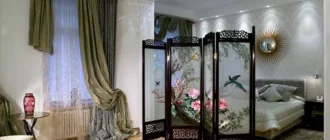
Queen Anne Style is the interior style of the early 18th century, which is characterized by romance, elegance and lightness. Queen Anne’s style is restrained and sophisticated, dominated by symmetry and soft flowing lines. The interiors remain luxurious, but get rid of excessive decor and massive status elements. They brighten, become more functional and more comfortable.

The main characteristics and features of the Queen Anne style
Queen Anne’s style (English Baroque) dates back to the period of classicism. It replaced the ponderous gloom of Tudor interiors and firmly established itself in the mansions of the English nobility. Symmetry and refined luxury reigned in the living rooms, the furniture lost its monumentality, its forms became more frivolous and playful.
Queen Anne’s style is also referred to as the “Walnut Age”. It was then, at the beginning of the 18th century, that massive oak furniture began to be replaced by openwork tea tables, light carved armchairs, high secretaries with inlaid, other interior elements made of walnut wood and carefully decorated.

One of the iconic objects of this period is considered to be a chair with a slotted back in the shape of a vase, cabriole legs and tapestry upholstery with a floral pattern. The back with an almost anatomical bend was decorated with the so-called “splat” – a detail borrowed by the masters of Misty Albion from Chinese furniture.
By the way, this chair is one of the first examples of a purely English furniture style. Until the beginning of the 18th century, island craftsmen copied French and Dutch furniture.
At the same time, magnificent armchairs-“cocoons” with tapestry floral upholstery and a high “eared” back that passes into the armrests take their place in the living rooms. At the same time, lacquered folding tables with folding side covers, elegant dressing tables with mirrors appeared. Thanks to the lush dresses that have come into fashion, chests are being replaced by chests of drawers.

The development of trade with Asian countries contributed to the growing popularity of various exotic decor.
The marine theme is extremely popular – on chairs, armchairs, beds are carved depicting jagged shells, deep-sea animals, including fabulous ones.
Bright, lacquered Chinese-style cabinets appear in living rooms. They are decorated with cornices-pagodas and rich painting: landscapes, flora and fauna. Other furniture is also abundantly varnished, as is customary in Asia.

Other prominent features of the Queen Anne style:
- Abundance of textiles in the setting. Rich draperies, large carpets with fancy ornaments, luxurious fabrics for upholstery, decorative pillows, bedspreads, light canopies.
- There is a lot of wood in the decoration of the rooms: wooden parquet, decorative elements, furniture, wall panels.
- Pilasters and stucco moldings, in which the influence of Greco-Roman culture is clearly visible.
- Symmetrically arranged decorative elements, proportional and symmetrical furniture.
- Restrained, noble colors, often pastel shades.
- Tall large mirrors.
- Mandatory attributes are framed paintings, tapestries, heavy candelabra, a fireplace with a richly decorated portal.

Queen’s style history
Anna Koroleva Anna Stewart (Anna of England; years of life 1665-1714), who gave the name to the interior style, ascended the throne at the age of 37, in 1702. However, the style, later named after her, began to take shape even before the reign of the last of the Stuarts. Anna’s sister, Maria, had previously become the wife of William III of Orange. He also brought Dutch furniture to England, which partly served as a prototype for English.
After William’s arrival in England, Huguenot emigrants who fled from France followed him. Among them was Daniel Marot, an engraver, renowned decorator, architect and draftsman. In England, Marot developed an original interior decor, based on the luxurious style of Louis XIV. Maro’s design evolved and over time transformed into the Queen Anne style.
Queen Anne’s reign did not last long. But the spectacular interior style that was given her name continued to develop and formed the basis of many eclectic trends of later times. The furniture trends that were laid down then remained relevant until the beginning of the 20th century.






